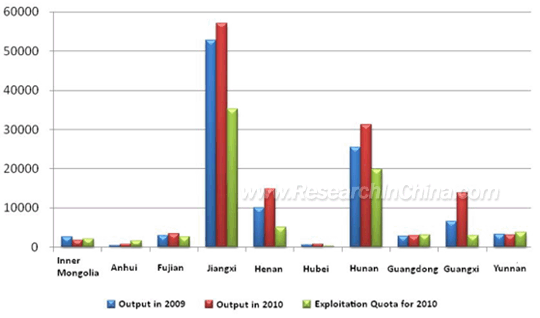How Much You Know About Tungsten
------Brief Introduction of Tungsten
When and Who find Tungsten?
In 1779 Peter Woulfe deduced the existence of a new element - Tungsten - from his analysis of the mineral wolframite (an iron manganese tungstate mineral).
Tungsten was isolated as tungstic oxide (WO3) in 1781 by Carl W. Scheele from the mineral scheelite (calcium tungstate). However he did not have a suitable furnace to reduce the oxide to the metal.
Tungsten was finally isolated by Fausto and Juan Jose de Elhuyar in 1783 by reduction acidified wolframite with charcoal.en and The element name comes from the Swedish words 'tung sten', meaning heavy stone.
The chemical symbol, W, comes from the original name of the element, Wolfram.
Classification: Tungsten is a transition metal
Color: silvery-white
Atomic weight: 183.84
State: solid
Melting point: 3422 oC, 3695 K
Boiling point: 5550 oC, 5823 K
Shells: 2,8,18,32,12,2
Electron configuration: [Xe] 4f14 5d4 6s2
Density @ 20oC: 19.3 g/cm3
Atomic volume: 9.53 cm3/mol
Structure: bcc: body-centered cubic
Hardness: 7.5 mohs
Harmful effects:
Tungsten is considered to be of low toxicity.
Characteristics:
Tungsten is a very hard, dense, silvery-white, lustrous metal that tarnishes in air, forming a protective oxide coating. In powder form tungsten is gray in color.
The metal has the highest melting point of all metals, and at temperatures over 1650 oC also has the highest tensile strength. Pure tungsten is ductile, and tungsten wires, even of a very small diameter, have a very high tensile strength.
Tungsten is highly resistant to corrosion. It forms tungstic acid (H2WO4), or wolframic acid from the hydrated oxide (WO3) and its salts are called tungstates, or wolframates.
Tungsten is one of the five major refractory metals (metals with very high resistance to heat and wear). The other refactory metals are molybdenum, tantalum, rhenium and niobium.
Applications or Uses of Tungsten
Tungsten and its alloys are widely used for filaments in older style (not energy saving) electric bulbs and electronic tubes. It is used for making heavy metal alloys because of its hardness. Tungsten is used for high-temperature applications such as welding.
High speed steel (which can cut material at higher speeds than carbon steel), contains up to 18% tungsten.
Tungsten carbide (WC or W2C) is extremely hard and is used to make drills. It is also used for jewelry because of its hardness and wear resistance.
Video of Tungsten
Picture of tungsten
http://www.chinatungsten.com/picture-bank/
The Large Area Telescope (LAT) explores cosmic rays by tracking the electrons and positrons they produce after striking layers of tungsten. Credit: NASA/Goddard Space Flight Center Conceptual Image Lab
 Abundance earth's crust: 1.25 parts per million by weight, 0.1 parts per million by moles
Abundance earth's crust: 1.25 parts per million by weight, 0.1 parts per million by moles
Abundance solar system: 4 parts per billion by weight, 30 part per trillion by moles
Cost, pure: $11 per 100g
Cost, bulk: $2.95 per 100g
Source: Tungsten is not found free in nature. The principal ores of tungsten are wolframite (an iron manganese tungstate) and scheelite (calcium tungstate, CaWO3). Comercially, the metal is obtained by reducing tungsten oxide with hydrogen or carbon.
Isotopes: Tungsten has 33 isotopes whose half-lives are known with mass numbers from 158 to 190. Of these, three are stable: 180W, 182W, and 186W. Specific heat capacity: 0.13 J g-1 K-1
Heat of fusion: 35.40 kJ mol-1
1st ionization energy: 770 kJ mol-1
3rd ionization energy: kJ mol-1
Heat of atomization: 860 kJ mol-1
Heat of vaporization : 824.0 kJ mol-1
2nd ionization energy: 1700 kJ mol-1
Electron affinity: 78.6 kJ mol-1
Shells: 2,8,18,32,12,2
Minimum oxidation number: -2
Min. common oxidation no.: 0
Electronegativity (Pauling Scale): 2.36
Electron configuration: [Xe] 4f14 5d4 6s2
Maximum oxidation number: 6
Max. common oxidation no.: 6
Polarizability volume: 11.1 Å3
Reaction with air: w/ht, ⇒ WO3
Reaction with 15 M HNO3: none
Oxide(s): WO2, WO3 (tungstic oxide)
Hydride(s):
Reaction with 6 M HCl: none
Reaction with 6 M NaOH:
Chloride(s): WCl2, WCl4, WCl6
Atomic radius: 139 pm
Ionic radius (2+ ion): pm
Ionic radius (2- ion): pm
Ionic radius (1+ ion): pm
Ionic radius (3+ ion): pm
Ionic radius (1- ion): pm
Thermal conductivity: 173 W m-1 K-1
Electrical conductivity: 18.2 x 106 S m-1
Collected by Hanns CEO/Chinatungten.com






